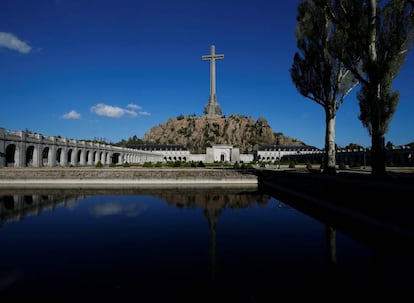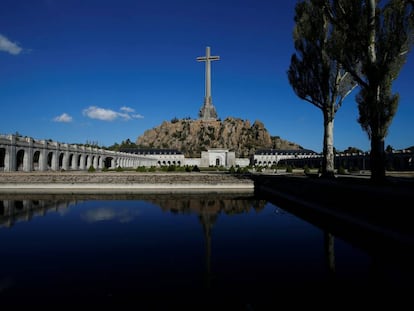Franco’s exhumation to take place on Thursday
After numerous setbacks, the Spanish government has announced that the body of the dictator will be transferred to a Madrid cemetery on October 24

The Spanish government has announced a date for the exhumation of Francisco Franco. The late dictator’s remains will be removed from the Valley of the Fallen monument on Thursday, October 24 at 10.30am, and transferred to the El Pardo-Mingorrubio cemetery, in Madrid.
The exhumation will take place shortly before a general election scheduled for November 10
The exhumation had been a signature initiative of the caretaker prime minister, Pedro Sánchez of the Socialist Party (PSOE), and it was approved by Spanish Congress on September 13, 2018.
But it ran into opposition from Franco’s family, which wanted his remains to stay at the Valley of the Fallen, a controversial monument located near El Escorial, in the mountains northwest of the Spanish capital. A series of legal challenges ended in late September when the Supreme Court authorized the exhumation.
The caretaker government had given itself until Friday to carry out the exhumation, but was delayed by events in Catalonia. The Valley of the Fallen has been closed to the public for more than a week, and the 50-kilometer distance between the Valley and the cemetery will probably be covered by helicopter, to prevent any potential roadblocks by pro-Franco demonstrators on the ground.
Valley of the Fallen
The 13.6-square-kilometer Valley of the Fallen site remains controversial in a country still struggling to come to terms with the legacy of the fascist dictatorship of Francisco Franco, who ruled over Spain from the end of the Civil War in 1939 to his death in 1975.
The site was ostensibly built to commemorate the victims on both sides of the war (1936-1939), and the unmarked remains of more than 33,000 victims of the conflict lie there. But critics point out that the Valley of the Fallen, which features a basilica and a 150-meter-high cross that dominates the surrounding countryside, contains just two marked graves: those of Franco himself and of José Antonio Primo de Rivera, the founder of the Falange, Spain's fascist-inspired political party. At the same time, thousands of prisoners of war who fought against Franco were among the workforce used in its construction.
The move will come shortly before a national election scheduled for November 10, and the PSOE administration is hoping that it will boost voter support at a time when many Spaniards are reeling from the week-long scenes of street violence seen in Catalonia, in the wake of the prison sentences against nine separatist leaders who headed the illegal secession bid in 2017.
The issue of Franco’s remains has been a thorny one throughout Spain’s democratic history. The PSOE was in power for 22 years before Pedro Sánchez became prime minister through a no-confidence vote in late May 2018, but neither one of his Socialist predecessors – Felipe González, who held office for 14 years, and José Luis Rodríguez Zapatero, who led the government for eight years – was able to find a solution to the fact that the dictator is buried in a giant mausoleum built by republican prisoners alongside 30,000 victims of the Civil War whose relatives do not want their remains to be there.
Franco is Europe’s only fascist leader to be buried in a grave at a landmark site that is a popular tourist attraction. The government wants the Valley of the Fallen to become a museum that will serve to explain the horrors of the dictatorship, mirroring similar initiatives in Germany and Argentina.
English version by Susana Urra.
Tu suscripción se está usando en otro dispositivo
¿Quieres añadir otro usuario a tu suscripción?
Si continúas leyendo en este dispositivo, no se podrá leer en el otro.
FlechaTu suscripción se está usando en otro dispositivo y solo puedes acceder a EL PAÍS desde un dispositivo a la vez.
Si quieres compartir tu cuenta, cambia tu suscripción a la modalidad Premium, así podrás añadir otro usuario. Cada uno accederá con su propia cuenta de email, lo que os permitirá personalizar vuestra experiencia en EL PAÍS.
¿Tienes una suscripción de empresa? Accede aquí para contratar más cuentas.
En el caso de no saber quién está usando tu cuenta, te recomendamos cambiar tu contraseña aquí.
Si decides continuar compartiendo tu cuenta, este mensaje se mostrará en tu dispositivo y en el de la otra persona que está usando tu cuenta de forma indefinida, afectando a tu experiencia de lectura. Puedes consultar aquí los términos y condiciones de la suscripción digital.
More information

The last Sundays with Franco
Archived In
Últimas noticias
Aquilino Gonell, former Capitol sergeant: ‘If it hadn’t been for the police, the US would be a dictatorship’
A hybrid building: Soccer pitch, housing, and a shopping mall
Europe urges Trump to respect Greenland following annexation threats
Science seeks keys to human longevity in the genetic mixing of Brazilian supercentenarians
Most viewed
- Alain Aspect, Nobel laureate in physics: ‘Einstein was so smart that he would have had to recognize quantum entanglement’
- Mexico’s missing people crisis casts a shadow over World Cup venue
- Why oil has been at the center of Venezuela-US conflicts for decades
- Trump clarifies who is ultimately in charge in Venezuela: ‘Me’
- Mexico seeks to shore up its defenses following US incursion in Venezuela










































